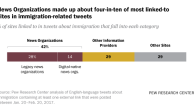Summary of Findings

The death of pop star Michael Jackson continued to grab public attention last week, with Americans saying it was the story they followed most closely for the third straight week. Moreover, Jackson’s death was by far the week’s most talked about news story.
About three-in-ten (29%) say they followed Jackson’s memorial service and the controversy surrounding his June 25 death more closely than any other major story last week. According to the latest weekly News Interest Index survey, conducted July 10-13 by the Pew Research Center for the People & the Press, a quarter say they tracked Jackson news very closely. That’s equal to the share that said they were following this story very closely one week earlier and down only slightly from 30% just after Jackson’s death.
When people are asked what recent news story they have been talking about with friends, 43% mention Jackson’s death. The economy ranks a distant second, mentioned by 18%, while several stories – including the resignation of Alaska Gov. Sarah Palin – tie for third with 8% each. People could offer as many as three responses.
The aftermath of Jackson’s death was also the week’s most reported story, according to a separate analysis by the Pew Research Center’s Project for Excellence in Journalism. With extensive coverage of the July 7 memorial service, as well as reports about alleged misuse of prescription drugs and a possible custody fight over his children, reporting on Jackson filled 17% of the newshole from July 6-12.

The many elements of the Jackson story continue to hold Americans’ interest – especially African Americans’ interest – as demonstrated by both the share following the story very closely and those talking about the story with friends. While more than four-in-ten (43%) mention Jackson’s death when asked what they have been talking about with friends, the share rises to two-thirds (67%) among African Americans. Although Jackson’s death is also the most mentioned story for whites, the proportion is smaller: 39%.
Close to two-in-ten (18%) of the public as a whole say they are talking with friends about the state of the economy, while 8% mention health care reform, Palin’s resignation or the murder of retired quarterback Steve McNair in Nashville. Smaller shares (6%) mention rising unemployment or certain crime stories. People mention many other stories, though no others top 4%. The total adds up to more than 100% because people could mention up to three stories.
Meanwhile, a greater share of African Americans (56%) than whites (18%) continues to say they are following the Jackson story very closely. The previous week, 48% of blacks said they were tracking news about Jackson very closely compared with 20% of whites.
For the public as a whole, the share that says they are following Jackson stories most closely – now 29% – has stayed at about three-in-ten since the weekend following his death.
Continuing Divide over Palin Coverage

Just as they were during the 2008 presidential campaign, Americans are divided in reactions to media coverage of Palin, last year’s GOP vice presidential candidate. The aftermath of Palin’s July 3 announcement that she was resigning as governor proved to be one of the most reported stories of the week, accounting for 7% of the newshole examined by PEJ, though a relatively modest share of the public (14%) say they followed this story very closely.
Four-in-ten (41%) say the press has been fair to Palin, while 36% say it has been too tough on her. Just 12% say it has been too easy. Partisans differ sharply. More than half of Republicans (54%) say the media has been too tough on Palin, compared with 20% of Democrats and 40% of independents. Among conservative Republicans, 65% say the media has been too tough. About half of Democrats (49%) say the media has been fair in its coverage, compared with 32% of Republicans and 38% of independents.
In early October, one month before the Nov. 4 election, 38% said they thought the media was being too tough on the Alaska governor and an equal share thought the media was being fair. About two-in-ten (21%) said the media had been too easy on her. At that time, the partisan differences were slightly wider: 63% of Republicans said the media was being too tough, compared with 18% of Democrats and 41% of independents.
The public is also divided about the amount of coverage that Palin has gotten recently, with 38% saying they are hearing too much about Palin and 40% saying they are hearing the right amount. Almost half of Republicans (47%) say they are hearing the right amount about Palin’s plans, compared with 31% of Democrats and 44% of independents. A plurality of Democrats (45%) say they are hearing too much about Palin, compared with 27% of Republicans and 38% of independents. Close to six-in-ten (58%) liberal Democrats say they are hearing too much about Palin, while 52% of conservative Republicans say they are hearing the right amount.
Economy’s Troubles Closely Watched
As they have since the economic crisis began last fall, Americans also continue to closely track developments in the economy. Close to four-in-ten (37%) say they very closely followed the economy last week. Two-in-ten say the economy was the story they followed most closely, while economic news made up 11% of the newshole examined by PEJ.
About a quarter (24%) say they very closely followed the debate in Washington over health care reform. For 11%, this was the story they followed more closely than any other. Reporting on the health care debate accounted for 6% of coverage.
President Obama’s trip to Russia and the G-8 summit was very closely followed by 14% and was the most closely followed story for 12%. The media devoted 11% of the newshole to the president’s travels to Russia and Italy.
The public did not closely track the violent street fighting in western China between Muslim Uighurs and Chinese Han. Just 5% say they followed these stories very closely, while 2% say this was the story they followed most closely. According to PEJ, the media devoted 4% of the coverage to the riots in China.
Health Care Reform: Many Know About Public Plan and Potential Cost
The public appears to be well aware of key issues in the debate over whether and how to reform the nation’s health care system. About four-in-ten say they have heard a lot about the idea of a government health plan alternative to private insurance (41%) and the potential cost of the changes being debated (40%). Comparable percentages say they have heard a little about these two aspects of the debate (43% each).

A slightly smaller share (31%) says they have heard a lot about a possible plan to tax certain private health care benefits to help pay for coverage of more Americans, while 43% say they have a little about this. One quarter says they have heard nothing at all about it. Fewer say they have heard nothing at all about potential costs (17%) or a public health care plan alternative (16%).
A somewhat larger percentage of Republicans (37%) than Democrats (27%) say they have heard a lot about the proposal to tax some private health care benefits. This difference is more pronounced between self-described conservative Republicans and liberal Democrats (44% vs. 22%, of the groups have heard a lot about this proposal). On the two other health care issues examined in the survey, partisans are about equally likely to have heard a lot about them.
On each of these specific aspects of the health care debate, older Americans (those 65 and older) are more likely than those younger than 40 to have heard a lot about them.
NFL Quarterback’s Murder Widely Known
More than eight-in-ten say they have heard at least a little about the killing of quarterback Steve McNair in what police say was a murder-suicide by his 20-year-old girlfriend. Four-in-ten (41%) say they have heard a lot about McNair’s death, while 43% say they have heard a little. Men were somewhat more likely than women to have heard a lot about this story (46% vs. 36%), though large percentages of both men and women heard something about it.

Close to two-thirds say they have heard either a lot (26%) or a little (38%) about allegations that workers at a Chicago-area cemetery dug up and moved bodies so they could sell the spaces again. A smaller share had heard about a Philadelphia-area pool that rescinded an agreement to let children from a mostly minority summer camp program swim there. Close to half heard at least a little about this story (16% a lot, 31% a little). Still, a majority (53%) heard nothing at all about this.
A relatively small share say they heard a lot about a cyber security scare effecting U.S. and South Korean government web sites. Fewer than two-in-ten (15%) say they heard a lot about the computer attacks on the web sites, including well-used government sites; 36% heard a little about these stories. About half (49%) of the public heard nothing at all about the internet breach.
These findings are based on the most recent installment of the weekly News Interest Index, an ongoing project of the Pew Research Center for the People & the Press. The index, building on the Center’s longstanding research into public attentiveness to major news stories, examines news interest as it relates to the news media’s coverage. The weekly survey is conducted in conjunction with The Project for Excellence in Journalism’s News Coverage Index, which monitors the news reported by major newspaper, television, radio and online news outlets on an ongoing basis. In the most recent week, data relating to news coverage were collected from July 6-12, 2009 and survey data measuring public interest in the top news stories of the week were collected July 10-13, 2009 from a nationally representative sample of 1,000 adults.
About the News Interest Index
The News Interest Index is a weekly survey conducted by the Pew Research Center for the People & the Press aimed at gauging the public’s interest in and reaction to major news events.
This project has been undertaken in conjunction with the Project for Excellence in Journalism’s News Coverage Index, an ongoing content analysis of the news. The News Coverage Index catalogues the news from top news organizations across five major sectors of the media: newspapers, network television, cable television, radio and the internet. Each week (from Monday through Sunday) PEJ compiles this data to identify the top stories for the week. The News Interest Index survey collects data from Friday through Monday to gauge public interest in the most covered stories of the week.
Results for the weekly surveys are based on telephone interviews among a nationwide sample of approximately 1,000 adults, 18 years of age or older, conducted under the direction of ORC (Opinion Research Corporation). For results based on the total sample, one can say with 95% confidence that the error attributable to sampling is plus or minus 3.5 percentage points.
In addition to sampling error, one should bear in mind that question wording and practical difficulties in conducting surveys can introduce error or bias into the findings of opinion polls, and that results based on subgroups will have larger margins of error.
For more information about the Project for Excellence in Journalism’s News Coverage Index, go to www.pewresearch.org/pewresearch-org/journalism.




